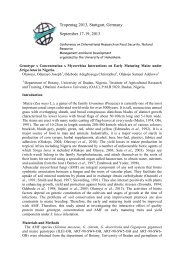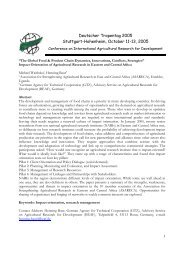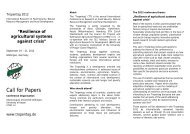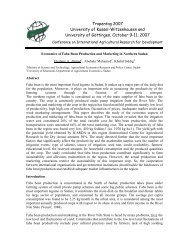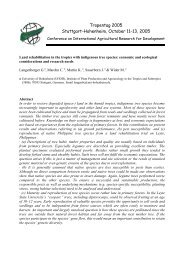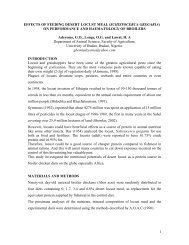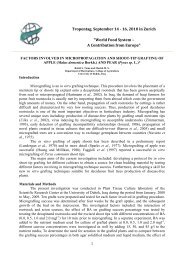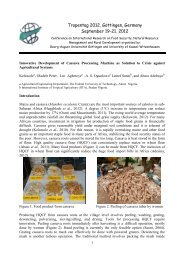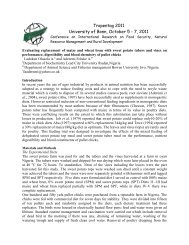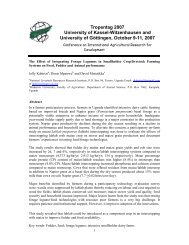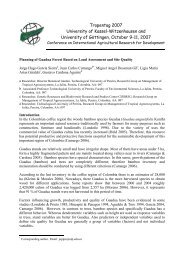Yield Component of Amaranth (Amaranthus spp ... - Tropentag
Yield Component of Amaranth (Amaranthus spp ... - Tropentag
Yield Component of Amaranth (Amaranthus spp ... - Tropentag
You also want an ePaper? Increase the reach of your titles
YUMPU automatically turns print PDFs into web optimized ePapers that Google loves.
<strong>Tropentag</strong> 2007University <strong>of</strong> Kassel-Witzenhausen andUniversity <strong>of</strong> Göttingen, October 9-11, 2007Conference on International Agricultural Research for Development<strong>Yield</strong> component <strong>of</strong> <strong>Amaranth</strong> (<strong>Amaranth</strong>us <strong>spp</strong>.) grown under Northern Thailandirrigated areaSa-nguansak Thanapornpoonpong a , Wiwat Somsak a , Elke Pawelzik b and Suchada Vearasilp a*a Chiang Mai University, Department <strong>of</strong> Agronomy, Thailandb Georg-August-Universität Göttingen, Department <strong>of</strong> Crop Sciences, Quality <strong>of</strong> Plant Products, GermanyIntroductionGrain amaranth (<strong>Amaranth</strong>us <strong>spp</strong>.) is protein-rich pseudocereal. It has been received the attentionby many researchers due to the valuable sources <strong>of</strong> protein and amino acids which are deficient inother cereals (AHAMED ET AL., 1998). It is also used for the production <strong>of</strong> healthy food in severalworld regions (NATIONAL RESEARCH COUNCIL, 1989). The amino acid composition <strong>of</strong> theirproteins corresponds to the FAO standards for human nutrition. Their lysine and phenylalanineperform better pr<strong>of</strong>ile than other cereals such as wheat, maize and oat. Their unsaturated fattyacid compositions and content are in balanced spectrum. In addition, it is also contained highcrude fiber content (THANAPORNPOONPONG, 2004). The plant height <strong>of</strong> amaranth are variedbetween 0.5 to 3 m. Their total biomass are varied between 720 to 1320 g m -2 and obtain 140 to300 g m -2 grain. The harvest indexes (HI) is ranging from 0.2 to 0.3 (AUFHAMMER ET AL., 1995,SPEHAR ET AL., 1998). It can grow well even under unfavorable environmental conditions. InChina, India and Nepal cultivation trials have been undertaken (BERGHOFER AND SCHOENLECHNER,2002). Effects <strong>of</strong> environmental conditions on yield have been reported (HENDERSON ET AL.,2000). The semidwarf cultivar ‘K432’ produced low grain yield in dry environments but thehighest grain yield under cool and moist conditions is obtained. However, information about thegrowing factors influence to the yield performance in Thailand is very rare. The aim <strong>of</strong> this studywas to evaluate the possibility to produce amaranth seeds under the climatic condition <strong>of</strong>Northern Thailand.Material and methodsThis experiment was carried out at Department <strong>of</strong> Agronomy, Faculty <strong>of</strong> Agriculture, Chiang Maiuniversity, Chiang Mai, Thailand, from November 2006 to March 2007. Randomized completeblock design (RCB) with three replications was used. Eight varieties <strong>of</strong> grain amaranth as follow:“K266”, “Dobos”, “Bärnkraft”, “AMR”, Rawa”, “K432”, “K283” and “Pastevny” werecultivated with the plot size <strong>of</strong> 15 m 2 per each variety. Pre-planting fertilizer was used at the rates<strong>of</strong> 30 kg N ha -1 and top dressing with 30 kg N ha -1 at the flowering stage. Carbosulfan was usedfor insect control. Weed was controlled by hands. Water was sprinkled every three days. Cropdensity management was done by rouging after 14 days <strong>of</strong> emergence to 20 plants m −1 . Plantheight was measured at the maturity stage. The periods <strong>of</strong> vegetative growth and reproductivegrowth were recorded._______________________* Corresponding author. Email: suchada@chiangmai.ac.th1
After harvest, grain yield, plant dry weight, thousand-kernel weight and harvest index weredetermined. Weight measurement was adjusted to 11 % moisture content. Analysis <strong>of</strong> variancewas done according to ANOVA. The means were compared by using least significance differencetest (LSD0.05).Results and DiscussionIn the initial step <strong>of</strong> investigation, significant differences growth periods between cultivars weredetermined (Figure 1). When compared the vegetative growth periods <strong>of</strong> all varieties, it wasfound that the amaranth variety “K432” and “Pastevny” had shorter vegetative growth periodsthan the other varieties (23 and 22 days, respectively). It showed that both varieties had earlyflowering and this cause affected to impediment plant growth and lower grain yields finally(Figure 2 and Table 1). All varieties were harvested according to their maturity 90 to 101 daysafter germination (DAG). The “Pastevny” variety was harvested earlier than the other varieties(90 DAG). The other varieties showed no significantly difference in harvest periods.K2663958Dobos4851Bärnkraft4952VarietyAMRRawa48485351Vegetative stageReproductive stageK4322374K2834456Pastevny2268Figure 1: Growth periods <strong>of</strong> grain amaranth varieties0 20 40 60 80 100Days after germination (days)For plant height, the variety “Dobos”, “K432” and “Pastevny” were significantly different butmean <strong>of</strong> them are lower than plant height <strong>of</strong> other varieties (Figure 2 and Table 1). Although,“Dobos” variety had longer vegetative growth period than “K432” and “Pastevny” variety, butthey showed poor vegetative growth. This result presented that “Dobos”, “K432” and “Pastevny”variety do not seem suitable for cultivation under Northern Thailand climatic conditions.120Plant height (cm)100806040200K266DobosBärnkraftAMRRawaK432K283Pastevny7 14 21 28 35 42 49 56 63 70 77 84Days after germination (days)Figure 2: Plant height <strong>of</strong> grain amaranth2
Table 1: Plant height, grain yield, plant dry weight, thousand-seed weight (TSW) and HI <strong>of</strong> grainamaranthVarietiesPlant height Plant dry Grain yield TSW HI(cm) weight (g) (g plant -1 ) (g)K266DobosBärnkraftAMRRawaK432K283Pastevny84.8 a47.6 b96.6 a101.8 a87.8 a38.0 b85.5 a51.9 b19.1 a7.6 bc18.0 a12.1 abc16.1 ab7.2 c17.8 a4.5 c5.05 a1.90 cd5.95 a3.86 abc4.13 ab2.28 bcd3.97 abc1.05 d0.701.070.850.940.850.840.710.850.27 ab0.24 b0.34 a0.32 a0.27 ab0.32 a0.22 b0.24 bLSD 0.05 21.6 8.52 2.23 - 0.08The values <strong>of</strong> mean which are following by the same letter had p>0.05, and therefore, theywere not characterized as significantly differentPlant growth rate <strong>of</strong> most varieties had increased after 56 DAG. <strong>Amaranth</strong> “K266”, “Bärnkraft”and “K283” variety produced significantly plant dry weight which higher than “Dobos”, “K432”and “Pastevny” varieties (Table 1 and Figure 3). Furthermore, the grain yield <strong>of</strong> “K266” and“Bärnkraft” variety were also significant and it higher than “Dobos”, “K432” and “Pastevny”varieties. These results showed the significantly positive correlations between plant height, grainyield and plant dry weight (Table 2)20Plant dry weight (g)15105K266DobosBärnkraftAMRRawaK432K283Pastevny014 28 42 56 70 84Days after germination (days)Figure 3: Plant dry weight accumulation <strong>of</strong> grain amaranthTable 2: Correlations between plant height, plant dry weight, grain yield, HI and TSW <strong>of</strong> grainamaranthPlant height Plant dry weight Grain yield Harvest IndexPlant dry weight 0.70 **Grain yield 0.77 ** 0.93 **Harvest Index 0.25 0.00 0.34TSW -0.26 -0.41 * -0.32 0.13* Significant at the 0.05 probability level** Significant at the 0.01 probability level3
The TSW was varies in the range from 0.70 to 1.07g and no significant differences wereobserved. This study was given that TSW had significantly correlated with plant dry weight. ForHI, it was varied between 0.22 to 0.34. The amaranth “AMR”, “Bärnkraft” and “K432” varietieshad significantly higher HI than “Dobos”, “K283” and “Pastevny” varieties (Table 1). However,the vegetative growth period <strong>of</strong> variety “K432” was shorter than the others, then it should bedeselected from the future investigation.From all data <strong>of</strong> this study, amaranth variety “AMR” and “Bärnkraft” were interested varieties,because, they showed good agronomic characteristics and higher grain yield and HI than theother varieties. When compared agronomic characteristics with the previous yield trail reportedby THANAPORNPOONPONG (2004) who grew the “Bärnkraft” variety in northern Germany, and thestudy was found the similar result in plant height (96.6 and 95.0 cm., respectively), grain yield(5.95 and 5.78 g plant -1 ). However, they showed higher HI (0.34 and 0.21, respectively) and thegrowth period <strong>of</strong> amaranth grown in Germany are longer than its grown in this study (107 and101 DAG, respectively).Conclusions and OutlookThe grain amaranth showed good agronomic and yield potential. Five varieties <strong>of</strong> grain amaranth(“AMR”, “Bärnkraft”, “K266”, “K283”, “Rawa”) were selected for using in the future research.The plant population density and various cultural practices will be investigated subsequently.This study can be concluded that the grain amaranth has well performances to produce underNorthern Thailand irrigated area.AcknowledgementsThis work was supported by Postharvest Technology Institute, Chiang Mai University. Anactivity <strong>of</strong> this research is subject related partnership between the University <strong>of</strong> Goettingen andChiang Mai University in the area <strong>of</strong> academic collaboration in teaching and research.ReferencesAHAMED, N.T., SINGHAL, R.S., KULKARNI, P.R., PAL, M. (1998). A lesser-known grain, Chenopodiumquinoa: Review <strong>of</strong> the chemical composition <strong>of</strong> its edible parts. Food and Nutrition Bulletin 19: 61-70.AUFHAMMER, W., KAUL, H. P., HERZ, P., NALBOREZYK, E., DALBIAK, A., GONTARCZYK M. (1995).Grain yield formation and nitrogen uptake <strong>of</strong> amaranth. European Journal <strong>of</strong> Agronomy 4: 379-386.BERGHOFER, E., SCHOENLECHNER, R. (2002). Grain amaranth. In: Belton, P.S., Taylor, J.R.N. (Eds.),Pseudocereals and less common cereals., 219-260; Springer-Verlag Berlin Heidelberg, Germany.HENDERSON, T. L., JOHNSON, B. L. and SCHNEITER, A. A. (2000). Row spacing, plant population, andcultivar effects on grain amaranth in the northern great plains. Agronomy Journal 92: 329-336.NATIONAL RESEARCH COUNCIL. (1989). Lost Crops <strong>of</strong> the Incas: Little-Known Plants <strong>of</strong> the Andes withPromise for Worldwide Cultivation. National Academy Press, Washington, D. C.SPEHAR, C. R., SANTOS, R. L. B. and JACOBSEN, S. E. (1998). Andean grain crop introduction to theBrazilian Savannah. In: International Conference on Sustainable Agriculture on Tropical andSubtropical Highlands with Special Reference to Latin America, Rio de Janeiro, Brazil.THANAPORNPOONPONG, S. (2004). Effect <strong>of</strong> nitrogen fertilizer on nitrogen assimilation and seed quality<strong>of</strong> amaranth (<strong>Amaranth</strong>us <strong>spp</strong>.) and quinoa (Chenopodium quinoa Willd). Dissertation. Fakultät fürAgrarwissenschaften, Georg-August-Universität Göttingen, Germany.http://webdoc.sub.gwdg.de/diss/2004/thanapornpoonpong/thanapornpoonpong.pdf4



